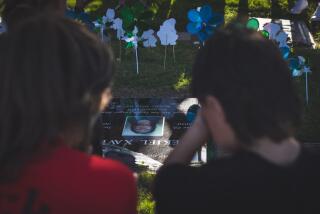Death Fuels Outrage Over Child Abuse : New Yorkers Mourn Battered Little Girl
- Share via
NEW YORK — Several hundred people gathered in Brooklyn Wednesday for the funeral of Jessica Cortez, the 5-year-old whose brutal death by beating has horrified a city already unnerved by a sensational child abuse trial under way in Manhattan.
“Children do not belong just to their parents. They belong to all of society,” the Rev. Donald Kenna told the mourners in a Mass conducted in Spanish and English. “We are not the people who are guilty, but we are responsible.”
Many of those gathered in the rain had never known the girl whose body lay in the little white coffin. Their presence underscored public outrage over her death, from a beating that broke her neck, and over the fatal beating of 6-year-old Lisa Steinberg a year ago.
Joel Steinberg, the attorney who was Lisa’s adoptive father, is on trial for her death. The court proceedings have been so riveting that stations interrupted regular programming earlier this month to carry several days of testimony from Hedda Nussbaum, Steinberg’s lover.
Violent, Squalid Life
Nussbaum, still bearing marks she attributed to Steinberg’s beatings, was the prosecution’s star witness as she described a life of violence and squalor that left her too broken to defend her child.
Although both deaths have drawn attention to child abuse, the Cortez case has disintegrated into finger-pointing on the part of politicians seeking to avoid the blame for the apparent inadequacies of social agencies.
Although no one knows how widespread the problem is, city officials say the number of reports of child abuse and neglect has been rising--to 55,000 last year from 46,000 in 1986. In part, the increase can be traced to a heightened public awareness, but Suzanne Trazoff of the Human Resources Administration said that “the single most responsible element is the arrival in New York three years ago of crack,” the potent cocaine derivative.
Increasingly, blame is also being placed on city agencies that are supposed to protect children. The city reportedly was alerted to serious problems in Jessica’s family as early as 1983, but nevertheless assured a court in a 1986 custody dispute that Abigail Cortez was “a good mother.”
The 25-year-old mother did not attend the funeral but appeared for a brief court hearing, which was recessed and scheduled to resume on Friday. Her live-in boyfriend, Adrian Lopez, also 25, has been indicted, but details of the charges have not been released.
William J. Grinker, head of the city’s Human Resources Administration, suggested on Monday that his agency is being made a scapegoat and is prevented by a state law from defending itself. The law imposes criminal penalties for disclosing details of reports of child abuse.
Recriminations escalated as Mayor Edward I. Koch went so far as to say he would “like to choke” state Social Services Commissioner Cesar A. Perales because he would not allow Grinker to bend that law.
“He wants to choke off the truth,” Koch said of Perales. “He wants to prevent the public from knowing what happened.” The mayor subsequently apologized for his remarks.
“Because of our inability to talk, it looks as if we are somehow responsible,” Trazoff said. “This agency too often ends up somehow being scapegoated for everything that goes wrong.” Ultimately, she said, the facts will show “a very complicated case (but) the judgment calls that were made were reasonable.”
In the meantime, New Yorkers are haunted by front-page photographs, taken 16 months ago, of a beaming and apparently healthy Jessica in a frilly red-and-white party dress. Her battered body, also reported to have shown signs of sexual abuse, was found in her family’s apartment on Dec. 14 and, 20 hours later, her 9-year-old brother, Nicholas, was discovered in a nearby closet, frightened and bruised and suffering from malnutrition.
For all the headlines such cases produce, at least one New York lawyer who represents abused children predicts that they will lead to few solutions. Andrew H. Vachss said public attention becomes riveted on a handful of horrifying cases, but quickly fades because the media have “a short attention span.”
Meanwhile, the social services system “hasn’t got a chance. It’s designed not to have a chance,” Vachss said.
City officials insist that social agencies dealing with child abuse have received increased funds at a time when other city divisions are suffering cuts, but Vachss said the problem goes beyond inadequate budgets and heavy caseloads.
“Everything takes place in darkness. No one knows the extent of the problem,” he said. “What we do are body counts. We don’t do documentation.”
In addition, he said, there is a basic conflict in a system that seeks to “simultaneously rehabilitate abusers and protect victims. It’s an impossible task.”
More to Read
Sign up for Essential California
The most important California stories and recommendations in your inbox every morning.
You may occasionally receive promotional content from the Los Angeles Times.













